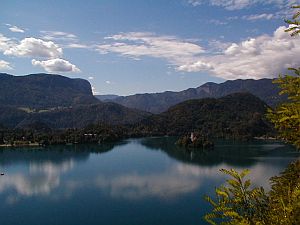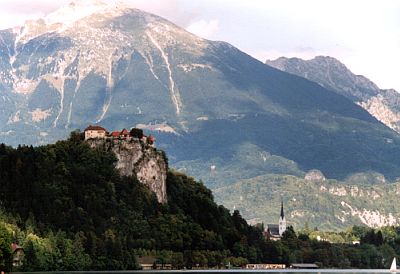Official Name
Bled. The German name of the town is Veldes. The full name of the famous lake itself is Blejsko Jezero (jezero=lake).
Location

| ||
| Bled |
Bled and the lake are tucked away in the north-west corner of Slovenia, some 60 km away from the capital →Ljubljana. The closest border crossing to Austria at Jesenice is around 20 km away to the north; the Italian border crossing at Fusine is more than 40 km away. The average altitude of Bled is 500 m above sea level.
The settings couldn't be better - to the north, the large Karawanken (Karavanke) range marks the border to Austria, to the west the Julian Alps with the 2,864 metres high Triglav in the middle dominates the scenery. Mt Triglav also marks the centre point of Triglav National Park. The lake and the town do not belong to the national park. The town and the lake lie between two small rivers feeding the river Sava, a tributary of the Danube, near Bled.
Population
Around 5,500 inhabitants. The town can accommodate up to 4,000 visitors. In summer, visitors usually outnumber the locals.
Orientation
The small city of Bled lies at the eastern shore of the lake and is rather hilly, so it's not possible to see everything at once. The bus station faces the long main road Prešernova Cesta and is quite central. From there, it takes less than 5 minutes to walk to the lake. The town is a nice and green, fashionable resort with an appropriate atmosphere. However, don't expect any architectural jewels in town. The only exception is the fantastic castle towering high above the lake not far from the town. The tourist information can be found inside Hotel Park not far from the lakeshore.
There's no central train station. One of the two stations lies east of Bled, is called Lesce-Bled and is more than 4 km away. Another, but less important station is located on the top of a hill near the western lakeshore. The station is called Blejsko Jezero Stanzio. From there, it's around 3 km to the town.

| ||
| Lake Bled and the beautiful surroundings |
History
In the year 2004, Bled celebrated its 1000th anniversary. But the area around the lake was inhabited long before the dawn of recorded history. This doesn't come as a surprise, since the naturally protected area is a perfect place to settle. In the year 1004, the German emperor Heinrich II gave the area around Bled to the bishop of Brixen (a small town in the Italian part of South Tyrol) as a present (that's what I call I nice gift!). Soon after that, the emperor gave away the castle, too. Apart from short interruptions, Bled belonged to the clergymen of Brixen until the 19th century.
Bled has always been popular with pilgrims heading for the church on the tiny island (see below). Since 1850, less clerical visitors discovered the favourable climate, the minreal springs and the beautiful landscape of Bled. Among them was the Swiss doctor Arnold Rikli, who started making use of Bled's quality as a health resort. Ever since, the place was a famous resort no matter who ruled the country. The Serbian royal family as well as Tito had their summer residences in Bled. It was not before 1960 that Bled was granted the right to call itself a town. The popularity of the town has not waned at all - especially during the summer months the town becomes very crowded with tourists.
Getting there / transportation
The above mentioned train station Lesce-Bled is one of the stations along the international railroad from Munich (!) to İstanbul resp. Athens (!!!). This means that it's easily accessible by train. But as already mentioned above, the train station is more than 4 km away from the centre. Shuttle buses run between the station and the town. For more details on how to get to Slovenia and the capital Ljubljana see →Travel information Slovenia. From Ljubljana to Bled it takes almost one hour by train, but only five trains a day stop in Lesce Bled.
It's much better to go by bus. The bus needs slightly more than one hour from Ljubljana, but it stops right in the centre of Bled. There are several dozen buses each day - at least during the summer months. The fare for a single ticket is around € 5.
Indeed, Bled is a veritable place to be. There's almost everything you need for a perfect landscape: Snow-covered mountains, a crystal clear lake, a tiny islet with a small church on it, a remarkably warm climate and a fairytale castle on a more than 100 metres high rock towering above the lake. Have I forgotten something? Yes, and more or less warm mineral springs. It is little wonder that Bled is a highly popular place.

| ||
| Bled Castle and the Karavanke range |
The lake itself is rather small - the water surface is 144 hectares only. It stretches around 2,100 metres from east to west and less than 1,400 metres from north to south. The maximum depth is 30 metres only. Natural mineral springs with an average water temperature of 23° feed the lake. The mineral water can also be used to cure infirmities. Not only thanks to the springs, the water is unusually warm making it possible to splash around even in autumn - a rarity in the Alps. This phenomenon is also possible because of the massive mountain range in the north, preventing cold winds from falling in. Hence, it's quite warm in the summer and comparatively moderate in winter.

| ||
| Bled island and church |
The town itself is not particularly interesting and quite calm - except for the hordes of tourists. The cultural highlight is the Blejski Grad (Bled Castle) west of the centre. The castle occupies a more than 100 m high rock towering above the lake. The castle was used as the residence of the Bishops of Brixen. As already mentioned above, the bishops owned the town as well as the castle for around 800 years. Today, the castle houses an interesting historic museum, a nice, old chapel and a restaurant. Admission fee is € 2. However, the most interesting thing about the castle is the splendid view over the lake.
In the centre of the western half of the lake, there's the tiny Blejski Otok (Bled Island). The mystical island is not very large, leaving only enough space for a church and a few trees. The church was probably first built during the 8th or 9th century. The present Baroque church is much younger. The belfry dates back to the year 1534. Devica Marija cerkev (St Maria Church) has always been a very popular place of pilgrimage. It is said that there was once a temple dedicated to a Slav goddess behind the church.
A boat takes visitors to the island. There are two landing stages - one in the town, another one at the closest point to the island on the southern shore. The return fare is € 5, the boat doesn't leave before it's full. There's a very nice hiking trail leading all the way around the lake. The trail is less than 10 km long, so it's a pleasant 2 hours walk. The southern shore as well as the area around the town are not very attractive - the nice view is obstructed by countless hotels and other buildings. However, there are nice and calm places along the northern and western shore, where you can enjoy the crystal clear, emerald green water of the lake in the front and the high mountains in the back - with the small island in the middle. Indeed, a picture post card idyll.
Needless to say that the area around Bled is the perfect place for hiking and climbing. Vintgar Gorge, some 4 km north-west of Bled, is a popular destination. West of Bled, you can see the distinctive three-headed Mt Triglav (2,864 m), the highest summit of Slovenia. Everyone can climb Mt Triglav during the summer months, providing that you are in good condition.
We returned to →Ljubljana the same day, so I cannot recommend a place. But as already mentioned above, there's more than plenty of accommodation in town - camp sites, private rooms, hotels etc. The tourist information in town can help. It's also possible to do Bled as a day trip.
- www.bled.si Well done, official website of Bled with plenty of useful information. In Slovenian, German and English.
Do you have or do you know a good website about Bled? Don't hesitate, let me know! After checking it, I would love to add it to the link list. You can submit a link by using the →contact form. Note that commercial websites will be treated differently.
©2024 Europe-East.com

 Albania
Albania Slovenia
Slovenia